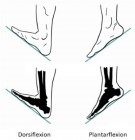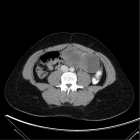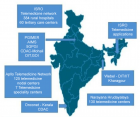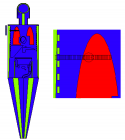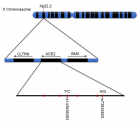Abstract
Editorial
Ocular changes and disorders associated with Obesity
Burak Turgut*
Published: 27 July, 2018 | Volume 2 - Issue 2 | Pages: 018-020
Obesity is a chronic and metabolic disease with a high increasing prevalence worldwide. It has multifactorial pathogenesis including genetic and behavioral factors [1-5]. Overweight and obesity have been defined and classified by the World Health Organization (WHO) and the National Institutes of Health (NIH) [2,3]. A person with a normal weight has Body Mass Index (BMI) of 18.5-24.9. A person with a BMI under 18.5 is called underweight. An adult having a BMI of 25-29.9 is overweight and pre-obese. Class 1 obesity is defined as a BMI between 30.00-34.99. Class 2 (Severe) Obesity is to have a BMI between 35.00-39.99. Morbid (Extreme, Class 3) obesity is to have a BMI over 40 [1-5]. Obesity is significantly associated with enhanced morbidity and mortality rates. It has also various economic, medical and psychological effects and causes health problems including many systemic diseases, economic costs and burdens, social and occupational stigmatization and discrimination and productivity loss [4-6]. Obesity carries the increased risk of development of many systemic and chronic diseases, including sleep apnea, depression, insulin resistance, Type 2 (adult-onset) diabetes, Gout and related arthritis, degenerative arthritis, hypertension, dyslipidemia, heart disease such as myocardial infarction, congestive heart failure, or coronary artery disease, polycystic ovary syndrome and reproductive disorders, Pickwickian syndrome (obesity, red face and hypoventilation), metabolic syndrome, non-alcoholic fatty liver disease, cholecystitis, cerebrovascular accident, colonic and renal cancer, rectal and prostatic cancer in males, and gallbladder, uterus and breast cancer in females [6-12].
In recent years, some publications reported that obesity has been strongly associated with some ocular diseases including age-related cataract and maculopathy, glaucoma, and diabetic retinopathy [13-16].
The recent reports demonstrated that the central corneal thickness and intraocular pressure were increased while as mean thickness of RNFL and retinal ganglion cell and choroidal thickness (CT) were decreased in the morbidly obese subjects [17-19]. However, another study has reported that CT increased in obese children [20]. On the other hand, a recent study reported that all values of the specific tests used to evaluate the ocular surface were within the normal range [21]. In some experimental studies, it has been demonstrated that obesity may cause retinal degeneration [22,23]. Additionally, in a past meeting presentation, it has been speculated that keratoconus is associated with severe obesity [24]. Teorically, idiopathic intracranial hypertension, and papilledema may also be associated with obesity [25]. Obesity may be also a cause of mechanical eyelid abnormalities such as entropion [26]. However, further investigations are needed to detect the significant relationship between these diseases and obesity.
On the other hand, the ocular surgeries of obese patients are difficult compared to normal weight-subjects. The posterior capsule rupture and vitreous loss may easily develop during cataract surgery of these patients because obese patients have an elevated vitreous pressure and operating table cannot often be lowered or surgeon’s chair cannot be elevated sufficiently to provide the clear viewing of the operating area and tissues. So, some different surgical manipulations such as standing phacoemulsification technique and reverse Trendelenburg position have been developed. Additionally, the standing vitrectomy technique has been used for vitreoretinal interventions in morbidly obese patients [27,28].
In conclusion, all obese subjects should be subjected to a completed ophthalmological examination and to relevant clinics for the detection of possible comorbidities and diseases
Read Full Article HTML DOI: 10.29328/journal.ijceo.1001015 Cite this Article Read Full Article PDF
References
- Purnell JQ. Definitions, Classification, and Epidemiology of Obesity. [Updated 2018 Apr 12]. In: De Groot LJ, Chrousos G, Dungan K, et al., editors. Endotext [Internet]. South Dartmouth (MA): MDText.com, Inc.; 2000.
- Web source. 2018. Ref.: https://tinyurl.com/nvs7gp .
- Web source. 2018. Ref.: https://tinyurl.com/ybnerz4z.
- Haslam DW, James WP. Obesity. Lancet. 2005; 366: 1197-1209. Ref.: https://tinyurl.com/yb35z5ds
- Sturm R, Hattori A. Morbid Obesity Rates Continue to Rise Rapidly in the US. Int J Obes (Lond). 2013; 37: 889-891. Ref.: https://tinyurl.com/yb5sdzrd
- Abdelaal M, le Roux CW, Docherty NG. Morbidity and mortality associated with obesity. Ann Transl Med. 2017; 5: 161. Ref.: https://tinyurl.com/yb8oxkvl
- Bianchini F, Kaaks R, Vainio H. Weight control and physical activity in cancer prevention. Obes Rev. 2002; 3: 5-8. Ref.: https://tinyurl.com/y8a8gu47
- Calle EE, Rodriguez C, Walker-Thurmond K, Thun MJ. Overweight, obesity, and mortality from cancer in a prospectively studied cohort of U.S adults. N Engl J Med. 2003; 348: 1625-1638. Ref.: https://tinyurl.com/y9rqw44d
- Eckel RH, Krauss RM. American Heart Association call to action: obesity as a major risk factor for coronary heart disease. AHA Nutrition Committee. Circulation. 1998; 97: 2099-2100. Ref.: https://tinyurl.com/y9d3wtk9
- Grundy SM. Metabolic complications of obesity. Endocrine. 2000; 13: 155-165. Ref.: https://tinyurl.com/y88fnzkn
- Lawrence VJ, Kopelman PG. Medical consequences of obesity. Clin Dermatol. 2004; 22: 296-302. Ref.: https://tinyurl.com/ya9hk7qq
- Pi-Sunyer FX. Medical hazards of obesity. Ann Intern Med. 1993; 119: 655-660. Ref.: https://tinyurl.com/y9y9sxv5
- Habot-Wilner Z, Belkin M. Obesity is a risk factor for eye diseases. Harefuah. 2005; 144: 805-809. Ref.: https://tinyurl.com/y97ghpjm
- Cheung N, Wong TY. Obesity and Eye Diseases. Surv Ophthalmol. 2007; 52: 180-195. Ref.: https://tinyurl.com/y8xp9hwo
- Mbata O, Abo El-Magd NF, El-Remessy AB. Obesity, metabolic syndrome and diabetic retinopathy: Beyond hyperglycemia. World J Diabetes. 2017; 8: 317-329. Ref.: https://tinyurl.com/yap6or2l
- Atchison E, Barkmeier A. The Role of Systemic Risk Factors in Diabetic Retinopathy. Curr Ophthalmol Rep. 2016; 4: 84-89. Ref.: https://tinyurl.com/yd84jm7a
- Dogan B, Kazim Erol M, Dogan U, Habibi M, Bulbuller N, et al. The retinal nerve fiber layer, choroidal thickness, and central macular thickness in morbid obesity: an evaluation using spectral-domain optical coherence tomography. Eur Rev Med Pharmacol Sci. 2016; 20: 886-891. Ref.: https://tinyurl.com/yahc6vy6
- Dogan B, Dogan U, Erol MK, Habibi M, Oruc MT. Comparison of anterior segment parameter values obtained with Scheimpflug-Placido topographer, optical low coherence reflectometry and noncontact specular microscopy in morbid obesity. Eur Rev Med Pharmacol Sci. 2017; 21: 438-445. Ref.: https://tinyurl.com/yaurdaoy
- Pacheco-Cervera J, Codoñer-Franch P, Simó-Jordá R, Pons-Vázquez S, Galbis-Estrada C, et al. Reduced retinal nerve fibre layer thickness in children with severe obesity. Pediatr Obes. 2015; 10: 448-453. Ref.: https://tinyurl.com/ybxfgcch
- Bulus AD, Can ME, Baytaroglu A, Can GD, Cakmak HB, et al. Choroidal Thickness in Childhood Obesity. Ophthalmic Surg Lasers Imaging Retina. 2017; 48: 10-17. Ref.: https://tinyurl.com/ybsjtf2b
- Marques NPN, Felberg S, Barros JN, Malheiros CA. Evaluation of the ocular surface following bariatric surgery. Arq Bras Oftalmol. 2017; 80: 247-251. Ref.: https://tinyurl.com/ycmoblg9
- Tiruvalluru M, Ananthathmakula P, Ayyalasomayajula V, Nappanveettil G, Ayyagari R, et al. Vitamin A supplementation ameliorates obesity-associated retinal degeneration in WNIN/Ob rats. Nutrition. 2013; 29: 298-304. Ref.: https://tinyurl.com/yax57k63
- Marçal AC, Leonelli M, Fiamoncini J, Deschamps FC, Rodrigues MA, et al. Diet-induced obesity impairs AKT signaling in the retina and causes retinal degeneration. Cell Biochem Funct. 2013; 31: 65-74. Ref.: https://tinyurl.com/ydd7ptws
- Kristinsson JK, Carlson AN, Kim T. Keratoconus and Obesity-A Connection? Invest Ophthalmol Vis Sci. 2003; 44: 812.
- Krispel CM, Keltner JL, Smith W, Chu DG, Ali MR. Undiagnosed papilledema in a morbidly obese patient population: a prospective study. J Neuroophthalmol. 2011; 31: 310-315. Ref.: https://tinyurl.com/y98byy4h
- Raina J, Foster JA. Obesity as a cause of mechanical entropion. Am J Ophthalmol. 1996; 122: 123-125. Ref.: https://tinyurl.com/y7ke7xnc
- Mansour AM, Al-Dairy M. Modifications in cataract surgery for the morbidly obese patient. J Cataract Refract Surg. 2004; 30: 2265-2268. Ref.: https://tinyurl.com/yajezpm7
- Mansour AM. Standing vitrectomy in morbid obesity. Retina. 2006; 26: 963-964. Ref.: https://tinyurl.com/y9flj4rk
Figures:
Similar Articles
-
A Comparative Study of Anatomic and Functional Outcomes of Two Surgical Techniques of Cataract at LomeAyena KD*,Santos KAM,Vonor K,Amedome KM,Wodome A,Strauss G,Nagbe YE,Koffi-Ametooyona A, Balo K. A Comparative Study of Anatomic and Functional Outcomes of Two Surgical Techniques of Cataract at Lome . . 2017 doi: 10.29328/journal.hceo.1001001; 1: 001-008
-
Theory and Experiments. (+) Add Reading Glasses to Prevent MyopiaPeter R Greene*,Brown OS. Theory and Experiments. (+) Add Reading Glasses to Prevent Myopia . . 2017 doi: 10.29328/journal.hceo.1001002; 1: 009-022
-
Efficacy of early Hyperbaric Oxygen Therapy in Central Retinal Artery OcclusionAyse Gul Kocak Altintas*,Mehmet Citirik. Efficacy of early Hyperbaric Oxygen Therapy in Central Retinal Artery Occlusion . . 2017 doi: 10.29328/journal.hceo.1001003; 1: 023-028
-
Mitomycin-C Use and Complications in OphthalmologyTongabay Cumurcu*. Mitomycin-C Use and Complications in Ophthalmology. . 2017 doi: 10.29328/journal.hceo.1001004; 1: 029-032
-
Intravitreal Ranibizumab/ Lucentis (IVTL) injections in Glaucoma patients-Intraocular Pressure (IOP) elevation and the use of Anterior Chamber Paracentesis (ACP)EA Ansari*. Intravitreal Ranibizumab/ Lucentis (IVTL) injections in Glaucoma patients-Intraocular Pressure (IOP) elevation and the use of Anterior Chamber Paracentesis (ACP) . . 2017 doi: 10.29328/journal.hceo.1001005; 1: 033-041
-
Detection of Ganglion Cell Loss in Preperimetric Glaucoma by Fourier-Domain Optical Coherence TomographySuneeta Dubey*, Baswati Prasanth,Lokesh Chauhan, Saptarshi Mukherjee. Detection of Ganglion Cell Loss in Preperimetric Glaucoma by Fourier-Domain Optical Coherence Tomography. . 2017 doi: 10.29328/journal.hceo.1001006; 1: 042-048
-
Intravitreal ranibizumab in the management of acute central serous ChorioretinopathyIbrahim Nawaiseh,Ahmad Halawa*,Dina Alardah. Intravitreal ranibizumab in the management of acute central serous Chorioretinopathy . . 2017 doi: 10.29328/journal.hceo.1001007; 1: 049-054
-
The Role of Omega-3 Essential Fatty Acids in Dry Eye DiseaseWilliam J Faulkner*. The Role of Omega-3 Essential Fatty Acids in Dry Eye Disease . . 2017 doi: 10.29328/journal.ijceo.1001008; 1: 055-059
-
Neuro-ophthalmological emergency disorders: A general viewBurak Turgut*,Feyza Çaliş Karanfil, Fatoş Altun Turgut. Neuro-ophthalmological emergency disorders: A general view . . 2017 doi: 10.29328/journal.ijceo.1001009; 1: 060-066
-
Prospective Clinical Study to Find out Epidemiology of Xerophthalmia in Children in a Tertiary Care Centre in IndiaDeepak Mishra*,Megha Gulati,Prashant Bhushan,Nilesh Mohan,Bibhuti Sinha P. Prospective Clinical Study to Find out Epidemiology of Xerophthalmia in Children in a Tertiary Care Centre in India . . 2017 doi: 10.29328/journal.ijceo.1001010; 1: 066-070
Recently Viewed
-
Evaluation of Long-term Antithrombotic Management for Atrial Fibrillation Patients with a History of Coronary Stent ImplantationKirsten Vyhmeister, Paul Gavaza, Murphy Nguyen, Grace Kang, Huyentran N Tran*. Evaluation of Long-term Antithrombotic Management for Atrial Fibrillation Patients with a History of Coronary Stent Implantation. Ann Clin Hypertens. 2024: doi: 10.29328/journal.ach.1001035; 8: 001-006
-
Call to Action! Hypertension and Dyslipidemia in Mexico: Underestimated Deadly DuoMartin Rosas-Peralta,Héctor Galván-Oseguera,Luis Alcocer,Humberto Álvarez-López,Ernesto Cardona-Muñoz,Silvia Palomo-Piñón,Enrique Díaz-Díaz,Adolfo Chávez-Mendoza,José Manuel Enciso-Muñoz. Call to Action! Hypertension and Dyslipidemia in Mexico: Underestimated Deadly Duo. Ann Clin Hypertens. 2024: doi: 10.29328/journal.ach.1001036; 8: 007-010
-
Sexual Dimorphism in the Length of the Corpus Callosum in CadaverShahnaj Pervin*,Nasaruddin A,Irfan M,Annamalai L. Sexual Dimorphism in the Length of the Corpus Callosum in Cadaver. J Neurosci Neurol Disord. 2024: doi: 10.29328/journal.jnnd.1001104; 8: 126-129
-
Analysis of Psychological and Physiological Responses to Snoezelen Multisensory StimulationLucia Ludvigh Cintulova,Jerzy Rottermund,Zuzana Budayova. Analysis of Psychological and Physiological Responses to Snoezelen Multisensory Stimulation. J Neurosci Neurol Disord. 2024: doi: 10.29328/journal.jnnd.1001103; 8: 115-125
-
Awareness level on the relevance of forensics in criminal investigation in NigeriaOmorogbe Owen Stephen,Orhue Osazee Kelvin,Ehikhamenor Edeaghe,Nwawuba Stanley Udogadi*. Awareness level on the relevance of forensics in criminal investigation in Nigeria. J Forensic Sci Res. 2021: doi: 10.29328/journal.jfsr.1001028; 5: 053-057
Most Viewed
-
Evaluation of Biostimulants Based on Recovered Protein Hydrolysates from Animal By-products as Plant Growth EnhancersH Pérez-Aguilar*, M Lacruz-Asaro, F Arán-Ais. Evaluation of Biostimulants Based on Recovered Protein Hydrolysates from Animal By-products as Plant Growth Enhancers. J Plant Sci Phytopathol. 2023 doi: 10.29328/journal.jpsp.1001104; 7: 042-047
-
Sinonasal Myxoma Extending into the Orbit in a 4-Year Old: A Case PresentationJulian A Purrinos*, Ramzi Younis. Sinonasal Myxoma Extending into the Orbit in a 4-Year Old: A Case Presentation. Arch Case Rep. 2024 doi: 10.29328/journal.acr.1001099; 8: 075-077
-
Feasibility study of magnetic sensing for detecting single-neuron action potentialsDenis Tonini,Kai Wu,Renata Saha,Jian-Ping Wang*. Feasibility study of magnetic sensing for detecting single-neuron action potentials. Ann Biomed Sci Eng. 2022 doi: 10.29328/journal.abse.1001018; 6: 019-029
-
Pediatric Dysgerminoma: Unveiling a Rare Ovarian TumorFaten Limaiem*, Khalil Saffar, Ahmed Halouani. Pediatric Dysgerminoma: Unveiling a Rare Ovarian Tumor. Arch Case Rep. 2024 doi: 10.29328/journal.acr.1001087; 8: 010-013
-
Physical activity can change the physiological and psychological circumstances during COVID-19 pandemic: A narrative reviewKhashayar Maroufi*. Physical activity can change the physiological and psychological circumstances during COVID-19 pandemic: A narrative review. J Sports Med Ther. 2021 doi: 10.29328/journal.jsmt.1001051; 6: 001-007

HSPI: We're glad you're here. Please click "create a new Query" if you are a new visitor to our website and need further information from us.
If you are already a member of our network and need to keep track of any developments regarding a question you have already submitted, click "take me to my Query."






